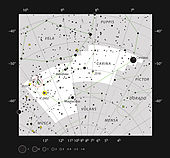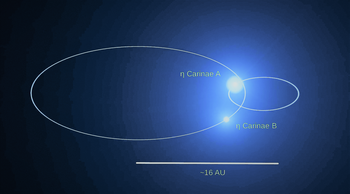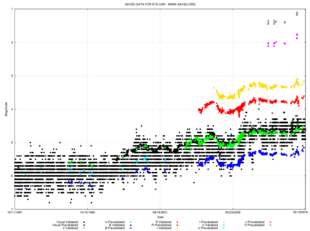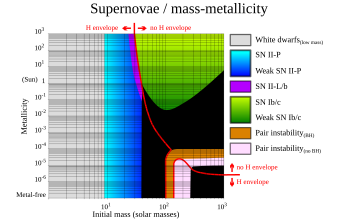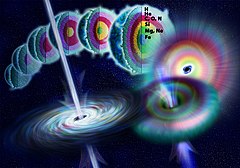Eta Carinae
There is no reliable evidence of η Carinae being observed or recorded before the 17th century, although Dutch navigator Pieter Keyser described a fourth-magnitude star at approximately the correct position around 1595–1596, which was copied onto the celestial globes of Petrus Plancius and Jodocus Hondius and the 1603 Uranometria of Johann Bayer.
[27] η Carinae is too far south to be part of the mansion-based traditional Chinese astronomy, but it was mapped when the Southern Asterisms were created at the start of the 17th century.
[2] John Herschel, who was in South Africa at the time, made a detailed series of accurate measurements in the 1830s showing that η Carinae consistently shone around magnitude 1.4 until November 1837.
The binary theory was confirmed by observations of radio, optical and near-infrared radial velocity and line profile changes, referred to collectively as a spectroscopic event, at the predicted time of periastron passage in late 1997 and early 1998.
[41][42] Radio, infrared and space-based observations have expanded coverage of η Carinae across all wavelengths and revealed ongoing changes in the spectral energy distribution.
[44][45] As a fourth-magnitude star, η Carinae is comfortably visible to the naked eye in all but the most light-polluted skies in inner-city areas according to the Bortle scale.
The broad P Cygni lines are typical of strong stellar winds, with very weak absorption in this case because the central star is so heavily obscured.
[53][54] The spectrum of light reflected from the Weigelt Blobs, and assumed to originate mainly with the primary, is similar to the extreme P Cygni-type star HDE 316285 which has a spectral type of B0Ieq.
Analysis of the reflected spectra indicated the light was emitted when η Carinae had the appearance of a 5,000 K G2-to-G5 supergiant, some 2,000 K cooler than expected from other supernova impostor events.
[42][43][59] The ultraviolet spectrum of the η Carinae system shows many emission lines of ionised metals such as FeII and CrII, as well as Lymanα (Lyα) and a continuum from a hot central source.
This allows almost the entire energy output of the system to be observed at wavelengths that are not strongly affected by interstellar extinction, leading to estimates of the luminosity that are more accurate than for other extremely luminous stars.
The emission is concentrated in a small non-point source less than 4 arcseconds across and appears to be mainly free-free emission (thermal bremsstrahlung) from ionised gas, consistent with a compact HII region at around 10,000 K.[79] High resolution imaging shows the radio frequencies originating from a disk a few arcseconds in diameter, 10,000 astronomical units (AU) wide at the distance of η Carinae.
This implies that η Carinae may be more distant than previously thought, and also more luminous, although it is still possible that it is not at the same distance as the cluster or that the parallax measurements have large systematic errors.
Until recently η Carinae was thought to be the most massive single star, but the system's binary nature was proposed by the Brazilian astronomer Augusto Damineli in 1996[9] and confirmed in 2005.
[98] Both component stars are largely obscured by circumstellar material ejected from η Carinae A, and basic properties such as their temperatures and luminosities can only be inferred.
An event similar to η Carinae A's Great Eruption has been observed in only one other star in the Milky Way — P Cygni — and in a handful of other possible LBVs in other galaxies.
Put simply, calculated mass loss rates in the best models of stellar evolution do not reproduce the observed properties of evolved massive stars such as Wolf–Rayets, the number and types of core collapse supernovae, or their progenitors.
(At extreme rates of radiative mass loss, the density gradient of lofted material may become continuous enough that a meaningfully discrete physical surface may not exist.)
[104] The stars of the η Carinae system are completely obscured by dust and opaque stellar winds, with much of the ultraviolet and visual radiation shifted to infrared.
The recent visual brightening is considered to be largely caused by a decrease in the extinction, due to thinning dust or a reduction in mass loss, rather than an underlying change in the luminosity.
[8] Further out, expanding gases from the Great Eruption collide with interstellar material and are heated to around 5 MK, producing less energetic X-rays seen in a horseshoe or ring shape.
[18] At the peak of the Great Eruption the radius, so far as such a thing is meaningful during such a violent expulsion of material, would have been around 1,400 R☉, comparable to the largest-known red supergiants, including VY Canis Majoris.
[16] It has been proposed that the initial brightening from 4th magnitude to 1st at relatively constant bolometric luminosity was a normal LBV outburst, albeit from an extreme example of the class.
Then the companion star passing through the expanded photosphere of the primary at periastron triggered the further brightening, increase in luminosity, and extreme mass loss of the Great Eruption.
Single massive stars spin down quickly due to braking from their strong winds, but there are hints that both η Carinae A and B are fast rotators, up to 90% of critical velocity.
[117] Possible explanations for the eruptions include: a binary merger in what was then a triple system;[118] mass transfer from η Carinae B during periastron passages;[16] or a pulsational pair-instability explosion.
Sufficiently massive or differentially rotating stars undergo such strong mixing that they remain chemically homogeneous during core hydrogen burning.
The elemental abundances at the surface cannot be accurately measured, but ejecta within the Homunculus are around 60% hydrogen and 40% helium, with nitrogen enhanced to ten times solar levels.
[126] In the case of η Carinae, the secondary is clearly causing additional instability in the primary, making it difficult to predict future developments.
The overwhelming probability is that the next supernova observed in the Milky Way will originate from an unknown white dwarf or anonymous red supergiant, very likely not even visible to the naked eye.


